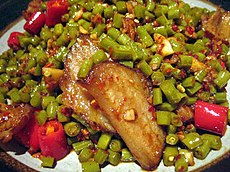Hunan_cuisine
Hunan cuisine
Branch of Chinese traditional cuisine native to Hunan province
Hunan cuisine, also known as Xiang cuisine, consists of the cuisines of the Xiang River region, Dongting Lake and western Hunan Province in China. It is one of the Eight Great Traditions of Chinese cuisine and is well known for its hot and spicy flavours,[1] fresh aroma and deep colours. Despite this, only about 20% of the cuisine uses capsicum to produce a strong spicy taste.[2] Common cooking techniques include stewing, frying, pot-roasting, braising and smoking. Due to the high agricultural output of the region, ingredients for Hunan dishes are many and varied.
| Hunan cuisine | |||||||||
|---|---|---|---|---|---|---|---|---|---|
 Hunan cured ham with pickled yardlong beans | |||||||||
| Chinese | 湖南菜 | ||||||||
| |||||||||
| Xiang cuisine | |||||||||
| Chinese | 湘菜 | ||||||||
| |||||||||
The history of the cooking skills employed in Hunan cuisine dates back to the 17th century.[1] The first mention of chili peppers in local gazettes in the province date to 1684, 21st year of the Kangxi Emperor.[3] During the course of its history, Hunan cuisine assimilated a variety of local forms, eventually evolving into its own style. Some well-known dishes include fried chicken with Sichuan spicy sauce (麻辣鸡丁; 麻辣雞丁; málà jīdīng) and smoked pork with dried long green beans (干豆角蒸腊肉; 乾豆角蒸臘肉; gāndòujiǎo zhēng làròu).
Hunan cuisine consists of three primary styles:[4]
- Xiang River style: Originating from Changsha, Xiangtan and Hengyang
- Dongting Lake style: Originating from Yueyang, Yiyang and Changde
- Western Hunan style: Originating from Zhangjiajie, Jishou and Huaihua
With its liberal use of chili peppers, shallots and garlic, Hunan cuisine is known for being gan la (干辣; gān là; 'dry and spicy')[5] or purely hot, as opposed to Sichuan cuisine, to which it is often compared.[1] Sichuan cuisine uses its distinctive ma la (麻辣; má là; 'spicy and numbing')[5] seasoning and other complex flavour combinations, frequently employs Sichuan pepper[1] along with chilies which are often dried. It also utilises more dried or preserved ingredients and condiments. Hunan cuisine, on the other hand, is often spicier by pure chili content and contains a larger variety of fresh ingredients. Both Hunan and Sichuan cuisine are perhaps significantly oilier than the other cuisines in China, but Sichuan dishes are generally oilier than Hunan dishes.[5] Another characteristic distinguishing Hunan cuisine from Sichuan cuisine is that Hunan cuisine uses smoked and cured goods in its dishes much more frequently.[4]
Hunan cuisine's menu changes with the seasons. In a hot and humid summer, a meal will usually start with cold dishes or a platter holding a selection of cold meats with chilies for opening the pores and keeping cool in the summer. In winter, a popular choice is the hot pot, thought to heat the blood in the cold months. A special hot pot called yuanyang huoguo (鸳鸯火锅; 鴛鴦火鍋; yuānyāng hǔogūo; 'Mandarin ducks hot pot') is notable for splitting the pot into two sides – a spicy one and a mild one.[6] One of the classic dishes in Hunan cuisine served in restaurants and at home is farmer pepper fried pork. It is made with several common ingredients: pork belly, green pepper, fermented black beans and other spices.[7]
| English | Traditional Chinese | Simplified Chinese | Pinyin | Notes |
|---|---|---|---|---|
| Changsha-style rice vermicelli | 長沙米粉 | 长沙米粉 | chǎngshā mǐfěn | |
| Changde-style stewed beef with rice vermicelli | 常德牛肉粉 | 常德牛肉粉 | chángdé niúròu fěn | |
| Changsha stinky tofu | 長沙臭豆腐 | 长沙臭豆腐 | chǎngshā chòu dòufu | |
| Cured ham with cowpeas | 酸豆角炒臘肉 | 酸豆角炒腊肉 | suān dòujiǎo chǎo làròu | |
| Dong'an chicken | 東安子雞 | 东安子鸡 | dōng'ān zǐjī | |
| "Dry-wok" chicken | 乾鍋雞 | 干锅鸡 | gānguō jī | |
| Home-style tofu | 家常豆腐 | 家常豆腐 | jiācháng dòufǔ | |
| Lotus seeds in rock sugar syrup | 冰糖湘蓮 | 冰糖湘莲 | bīngtáng xiānglián | |
| Mao's braised pork | 毛氏紅燒肉 | 毛氏红烧肉 | Máo shì hóngshāo ròu | |
| Mala chicken | 麻辣子雞 | 麻辣子鸡 | málà zǐjī | |
| Mashed shrimp in lotus pod | 蓮藕蝦仁 | 莲藕虾仁 | lián'ǒu xiārén | |
| Pearly meatballs | 珍珠肉丸 | 珍珠肉丸 | zhēnzhū ròuwán | |
| Pumpkin cake | 南瓜餅 | 南瓜饼 | nánguā bǐng | |
| Sautéed pork with chili pepper | 農家小炒肉 | 农家小炒肉 | nóngjiā xiǎo chǎoròu | |
| Smoky flavours steamed together | 臘味合蒸 | 腊味合蒸 | làwèi hézhēng | |
| Spare ribs steamed in bamboo | 竹筒蒸排骨 | 竹筒蒸排骨 | zhútǒng zhēng páigǔ | |
| Spicy crawfish | 香辣口味蝦 | 香辣口味虾 | xiāng là kǒu wèi xiā | [8] |
| Steamed fish head in chili sauce | 剁椒蒸魚頭 | 剁椒蒸鱼头 | duòjiāo zhēng yútóu | |
| Stir fried duck blood | 炒血鴨 | 炒血鸭 | chǎoxuéyā | |
| Stir fried meat with douchi and chili peppers | 豆豉辣椒炒肉 | 豆豉辣椒炒肉 | dòuchǐ làjiāo chǎoròu | |
| Yongfeng chili sauce | 永豐辣醬 | 永丰辣酱 | yǒng fēng làjiàng | |
A discussion of Hunan cuisine overall may list a number of piquant dishes, usually but not always very hot and spicy.[9]
- 王, 墨泉 (March 2018). 湘菜本色. 湖南人民出版社. ISBN 978-7-5438-9232-3.
{{cite book}}: CS1 maint: date and year (link) - "Why Revolutionaries Love Spicy Food". 14 April 2016. Archived from the original on 23 September 2020. Retrieved 21 May 2019.
- "Hunan Government Website International-enghunan.gov.cn Hunan Cuisine". www.enghunan.gov.cn. Retrieved 2024-03-13.
- B, Ivan (2019-07-28). "China Spice Wars: Sichuan Cuisine vs. Hunan Cuisine". Country and a Half. Retrieved 2024-03-13.
- "Hunan cuisine | China & Asia Cultural Travel". 2016-12-09. Retrieved 2024-03-13.
- Guo, Wei (2021-02-26). "Hunan Pork Stir-fry (湖南小炒肉)". Red House Spice. Retrieved 2024-03-13.
- "一城一味丨长沙:最令人神魂颠倒的,是口味虾的那口香辣 - 寻味湖湘 - 新湖南". www.hunantoday.cn. Retrieved 2021-08-31.
- Jiang, Yan (Apr 27, 2016). "Top 10 Hunan dishes you have to taste". Discover.china.org.cn. Archived from the original on 2016-08-14.